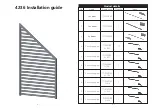
OPMAN-RC98AI_v2-0720
iii
Safety Alert Symbols
The
SAFETY ALERT SYMBOL
indicates there is a potential
hazard to personal safety involved and extra safety precaution must be
taken. When you see this symbol, be alert and carefully read the message
that follows it. In addition to design and configuration of equipment, hazard
control and accident prevention are dependent upon the awareness,
concern, prudence and proper training of personnel involved in the
operation, transport, maintenance and storage of equipment.
Owner/operator can prevent, and may be responsible for, accidents
or injuries occurring to other people, themselves, and/or property and
equipment.
Thoroughly read and understand the operation, references and other
material supplied with the Roping Chute. If the installer or operator
cannot read English, it is the owner’s responsibility to explain this
material to them.
We strongly recommend that children are not allowed to operate or
play on this equipment. Do not allow untrained people to operate
or service equipment.
Caution
Be familiar with equine activities and handling livestock prior to
use of this equipment. Working with livestock carries inherent risk of
injury or death.
Roping Chute and Equine Safety
Due to the inherent dangers associated with equestrian activities,
many states have adopted statutes pertaining to the liabilities of horse
owners, handlers, and individuals involved in equestrian activities.
Some states also require that you post signs at your facility with the
specific “Warning Law” on them, for personal and/or professional
equine activities. Posting these warning signs may help protect you
and/or your organization in the event an accident or injury does occur.
Please check the legal statute information in your state
2
.
Horses can be easily spooked and this is when injuries may occur.
One in three horse-related injuries happen when the rider/handler is
dismounted. These injuries typically involve the handler being kicked or
stepped on by the horse. Making sure all equine handlers are aware
of the dangers posed by frightened horses and what actions can scare
them can help prevent injuries. Some examples of things that can spook
a horse include, sudden or unexpected movements; loud or sudden
noises such as mobile phones or horns; other animals (i.e. unleashed
and/or barking dogs) and biting or stinging insects.
Priefert advises that individuals using this roping chute
have knowledge of equine activities, horse riding skills,
and, prior experience and training with cattle roping.
Installation / Operation Safety
•
Read and understand the operation instructions completely before
using this equipment. Locate equipment in a dry, level area.
•
Make sure any individuals operating this equipment understand the
instructions as well.
•
Priefert also recommends wearing personal protective clothing while
setting-up this roping chute, including gloves and safety glasses, as
well as, arm, leg, head and foot protection.
•
Allow only trained, qualified individuals to operate forklifts, tractors,
loaders or other vehicles used during installations; and that those
individuals are familiar with the operation of the specific vehicle used
during installations.
•
Operate equipment only during fair weather conditions.
•
Disconnect electric and/or pneumatic connections before performing
any service or repairs to the equipment. Remove all tools used during
installation from equipment before operation.
Safe Operation Guidelines
•
Use caution introducing livestock into the calf chute due to the
inherent danger associated with livestock.
•
Do not let children play in or on roping chute or its components.
•
Do not allow children to operate roping chute or its components.
•
Do not stick arms or legs through the chute rails anytime, especially
when a calf is loaded.
•
Make sure all guests or observers are clear of moving components
prior to chute operation.
•
Be cautious to prevent being confined between alleys while livestock
is present. Be cautious to prevent being caught between calves and
chute gates.
•
Be sure that horses used in roping activities are accustomed to the
actions of the roping chute, and handlers are familiar with equine
behavior.
•
Wearing proper clothing can help prevent injuries.
•
Always take into consideration the age, physical condition and
specific characteristics of calves used to prevent exceeding their
limitations and causing injury.
NOTE:
Provides helpful information to the operator.
IMPORTANT:
Indicates failure to observe may cause damage to
equipment.
WARNING:
Indicates a potentially hazardous situation which, if not
avoided, could result in death or serious injury, and includes hazards
that are exposed when guards are removed. It may also be used to alert
against unsafe practices.
1
CAUTION:
Indicates an imminently hazardous situation, which, if not
avoided, may result in minor or moderate injury. It may also be used to
alert against unsafe practices.
1
DANGER:
Indicates an imminently hazardous situation, which, if not
avoided, will result in death or serious injury. This signal word is limited
to the most extreme situations, typically for machine components that,
for functional purposes cannot be guarded.
1
BE AWARE OF SIGNAL WORDS: A signal word designates a degree of level of hazard seriousness.
1.
Sentry Insurance, FEMA,
Owner’s and Operators Manuals for Farm Equipment
, Sentry Insurance, Stevens Point, WI, revised Management Bulletin No. 112, 90-42;
March 2007, pp S-2.




























